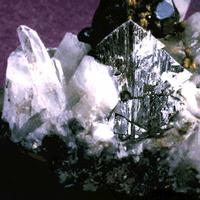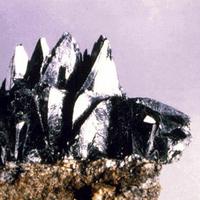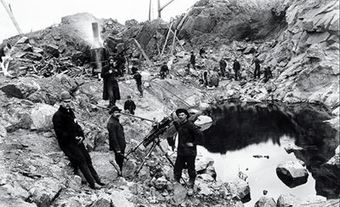Mineral
A mineral is an element or chemical compound formed in nature, usually by inorganic processes. Minerals may be composed of one element such as carbon (DIAMOND) or GOLD, or of several elements. Most minerals are characterized by a definite chemical composition, expressed by a chemical formula indicating the types and numbers of atoms, which are arranged in an orderly 3-dimensional pattern forming a crystalline material. Some solids (including natural glasses) and liquids (eg, water, mercury) lack the orderly atomic arrangement and are referred to as mineraloids.
COAL, PETROLEUM and amber lack a definite chemical composition and an orderly atomic structure; they are not minerals, although they are referred to as MINERAL RESOURCES. Pearls, CORAL and shells are composed of crystalline calcium carbonate and are referred to as biogenic minerals because they were formed by living organisms. Laboratory grown (synthetic) compounds are not minerals, although their chemistry and structure may be identical to naturally occurring minerals. There are about 3000 known mineral species; about 80 new species are discovered yearly.
To establish a new species, all data relating to the mineral, including its chemical, structural, physical and optical properties, must be approved by the Commission on New Minerals and New Mineral Names of the International Mineralogical Association. The association also judges the acceptability of the proposed name. Minerals are named in various ways, some in honour of a person ( weloganite, after Sir William E. LOGAN), a locality (athabascaite), an institution (mcgillite), the chemical composition (cobaltite), or a distinctive property such as colour (azurite) or shape (cylindrite).
Many names are derived from Latin or Greek words describing characteristic features, eg, albite [Lat albus, "white"] or rhodonite [Gk rhodon, "rose"]. All accumulated scientific data concerning the newly named mineral are published in a recognized international journal, such as the Canadian Mineralogist, for dissemination worldwide.
Minerals occur as components of rocks and, less commonly, as concentrations in rocks. Individual minerals may be readily recognized in coarse-textured rocks (eg, granite) but not in fine-grained rocks (eg, lava, shale). Concentrations of minerals range from small occurrences to large deposits and are formed by various processes, including solidification of mineral-bearing solutions in rock openings (eg, fissures, cavities), precipitation from mineral-rich waters as in springs and saline lakes, and solidification of gases during volcanic eruptions. In each case, minerals grow when appropriate temperature and pressure allow atoms in magma (molten rock), solutions or gases to group together into the basic, mineral-forming building blocks.
Structurally, minerals are grouped into 7 crystal systems, each giving rise to characteristic geometrical shapes. These systems - cubic (isometric), tetragonal, hexagonal, trigonal, orthorhombic, monoclinic and triclinic - are derived from 7 basic boxlike forms, each made up of atoms arranged in a precise and orderly fashion. During crystal growth, these basic building blocks align themselves symmetrically in 3 directions to produce a crystalline solid. If there is sufficient space during growth, a crystal with smooth geometrical faces, reflecting its internal structure, may form; usually, growth conditions are not ideal and minerals form as masses of generally microscopic crystals or in other aggregates (fibrous, powdery, flaky, globular, etc).
Minerals are defined and identified on the basis of their chemical composition and structure. A chemical analysis may range from a test for the presence of one or a few elements to a complete quantitative analysis. The techniques may be simple (eg, a flame test) or may involve sophisticated instruments (eg, electron microprobe, optical spectrograph). Minerals may, however, be identified without use of elaborate laboratory equipment. The most noticeable properties are those influencing appearance.
Form
Form, or habit, refers to the characteristic shape in which the mineral is formed. It may be fibrous (ASBESTOS), lamellar or scaly (MICA), platy (BARITE) or globular (hematite). Crystal forms, such as cubes and octahedra (fluorite and magnetite), rhombs (calcite) and 6-sided prisms (quartz and beryl) may also be readily recognized.Colour
Colour, if constant, as in the metallic minerals (gold, COPPER, chalcopyrite), may be diagnostic. Other minerals (eg, spinel, fluorite, corundum) may occur in various colours. Colour in minerals results from atoms or structural defects (colour centres) that absorb certain portions of the spectrum of light; the unabsorbed portion is reflected or transmitted to the eye as colour. The colour of the powdered mineral (its streak) is more reliable than that of the intact mineral. The streak is produced by rubbing the mineral across an unglazed porcelain plate. Yellow, brown or black sphalerite has a cream-white streak; black or reddish brown hematite has a dark red streak. Some minerals produce a fluorescent colour when exposed to ultraviolet light, eg, the white, TUNGSTEN-ore mineral scheelite fluoresces bluish white, a property used in PROSPECTING for it. Minerals that continue to fluoresce after the ultraviolet light source has been removed are referred to as phosphorescent.Lustre
Lustre, the reflection of light from mineral surfaces, is classified as metallic or nonmetallic. Various terms are used to describe nonmetallic lustre, including vitreous (glassy), adamantine (brilliant), resinous, waxy or oily, silky, pearly and earthy (dull). Lustre is generally more characteristic of a particular mineral than colour.
Transparency and Opacity
Transparency and opacity depend upon the mineral's ability to transmit or absorb light. Metallic minerals, strong light absorbers, are opaque. Transparent minerals transmit most incident light; these minerals are potential GEMSTONES. Translucent minerals both absorb and transmit light; objects viewed through them appear blurred. Some mineral species vary from transparent to almost opaque, depending upon the degree of impurity and structural defects they contain.Specific Gravity
Specific gravity is the density or weight of a substance, compared to the weight of an equal volume of water (specific gravity, 1). Galena, an ore of lead, has a density of 7.5, ie, it is 7.5 times heavier than water. The atomic weight of elements forming the mineral and the packing arrangement (ie, whether atoms are close or far apart) affect specific gravity. In stream gravels, minerals are separated by their specific gravity, heavier ones settling to the bottom.
Hardness
Hardness, the relative ability of a mineral to resist scratching or abrasion, is among the most useful diagnostic properties. The Mohs's mineral scale of relative hardness is used to assign an approximate hardness value to a mineral. The scale consists of 10 minerals in order of increasing hardness: TALC, 1: GYPSUM, 2; calcite, 3; fluorite, 4; apatite, 5; orthoclase, 6; quartz, 7; topaz, 8; corundum, 9; diamond, 10. Each mineral will scratch those with lower hardness and be scratched by those higher on the scale. Zircon, which scratches quartz but not topaz, has a hardness of 7.5. The hardness of a mineral depends upon the strength of the bonds, or electrical force, holding atoms together; the scratch breaks those bonds.Cleavage and Fracture
Cleavage, a smooth, flat break produced between planes of atoms, results from weakness in the force binding parallel planes of atoms to each other. Minerals may cleave in one or more directions, or not at all. Cleavage is described according to the number and direction of cleavage planes and by the smoothness of the cleavage surface (perfect, good, fair, poor). Mica minerals have a perfect cleavage in one direction and can be split into sheets. Galena has 3 cleavage directions at right angles to each other; each cleavage surface is parallel to a cube face and the cleavage is referred to as cubic. Fracture, a break across planes of atoms resulting in an irregular, nonplanar surface, occurs in minerals having no distinct planes of weakness. All minerals show some type of fracture; minerals that cleave in one or more directions may fracture in others. Fracture is described as conchoidal or shell-like (quartz, glass), hackly or jagged (native copper), splintery (jade) or uneven (FELDSPAR).Tenacity
Tenacity, or cohesiveness, is the breaking strength of minerals. "Tough" minerals (eg, jade) are so difficult to break that boulders are generally sawn. Brittle minerals shatter or crush to a powder when struck; diamond, the hardest mineral known, and talc, the softest, are brittle. Other minerals are deformed more easily than broken: a malleable mineral (gold) can be hammered into sheets; a sectile mineral (SILVER) can be cut into shavings; a ductile mineral (copper) can be drawn into wire; flexible minerals (GRAPHITE) can be bent; and elastic minerals (mica) will spring back after being bent.Magnetism and Radioactivity
Magnetism and radioactivity, properties shown by only a few common minerals, are easily detected. Magnetism refers to the reaction of a mineral in a magnetic field. Magnetite is strongly attracted to a hand magnet; pyrrhotite and ilmenite are less strongly attracted. Radioactive minerals (uraninite, thorite) contain unstable atoms (URANIUM, thorium) that emit radiation detectable by a scintillometer or a Geiger counter. In metamict minerals (betafite, allanite) radioactivity causes destruction of the internal atomic structure and the minerals become noncrystalline.Optical Properties
Optical properties refer to the behaviour of light passing through a mineral. Light travels more slowly in minerals than in air and the amount of slowing varies from mineral to mineral. With the loss of speed, light changes its path, or is refracted. The degree of slowing, referred to as the index of refraction, may be expressed as the ratio of the speed of light in air to the speed in a given mineral. For example, light travels at 299 330 km per second (km/s) in air (refractive index 1) but slows down to 123 916 km/s in diamond (ie, light travels 2.41 times as fast in air); hence the refractive index of diamond is 2.41.All minerals, except those in the cubic (isometric) system, bisect an incoming light ray when it travels along certain crystallographic directions. Each ray is slowed down to a different degree; hence, each ray will have its own index of refraction and the mineral will have 2 indices of refraction along certain directions. Such minerals are referred to as optically anisotropic; minerals with only one refractive index are described as isotropic. To determine the refractive index, mineralogists use the petrographic (polarizing) microscope; gemologists, the refractometer.
X-Ray Powder Diffraction
X-Ray powder diffraction is a universal laboratory method of mineral identification. The technique uses an X-ray source, a cylindrical camera lined with a strip of photographic film, and a small amount of the mineral powder mounted on a rod inside the camera. A beam of X-rays strikes the mineral, which reflects (diffracts) the X-rays from different sets of parallel planes of atoms; the reflected rays are recorded on the film as a series of concentric lines of varying intensities. The lines represent distances between atomic planes, and the intensities are related to the kind and distribution of atoms in the atomic plane. Since the distances and intensities of the lines (ie, the powder diffraction pattern) are characteristic for each mineral species, the film gives a "fingerprint" of that mineral. An unknown mineral is identified by matching its pattern with a standard pattern.Classification of Minerals
Modern mineral classification is based on chemical composition. Each chemical class is subdivided into groups or families according to similarities in structure and, to a lesser degree, in chemistry. Minerals in each group have similar properties and were formed in similar geological environments.Native Elements
The 20 or so minerals formed of one element include metals (eg, gold, silver), semimetals (arsenic, bismuth, ANTIMONY) and nonmetals (SULPHUR, carbon as graphite or diamond).
Sulphides, Sulphosalts
A sulphide mineral is composed of sulphur with one or more metallic elements (eg, galena, chalcopyrite) or sulphur with a semimetallic element (realgar). A sulphosalt, or double sulphide, is composed of sulphur with both metallic and semimetallic elements (pyrargyrite). Sulphides and sulphosalts are generally opaque, have metallic lustre and a hardness of 1-6, and occur commonly in veins. They include the important ore minerals.
Oxides, Hydroxides
Oxide minerals are composed of oxygen with one or more metals or semimetals (eg, hematite). If hydrogen is also present, as in goethite, the mineral is classed as a hydroxide. Oxides generally have simple chemistry and structure.
Halides
Halides are minerals composed of the halogen elements (fluorine, chlorine, bromine, iodine) with a metal (eg, halite or table salt, fluorite). Halides are generally soft, brittle and light in colour; some are water soluble. The halides form an important group of industrial minerals, including halite, sylvite (a source of potash), chlorargyrite (ore of silver) and fluorite.
Carbonates, Nitrates, Borates
Minerals in these classes have the same basic structural unit (ie, a radical) consisting of 3 oxygen atoms arranged in an equilateral triangle. In each class, a different type of atom is positioned in the centre of the triangle: the centre position in carbonates is occupied by a carbon atom and the radical is CO3; in nitrates by nitrogen (radical NO3); in borates by boron (radical BO3). Each triangular unit is held to similar ones by atoms of metallic elements. Carbonate minerals are most common; calcite and dolomite are the major constituents of LIMESTONE and marble. Carbonates are generally soft and soluble in acids; nitrates are water soluble and occur only in arid regions.
Sulphates, Phosphates, Chromates, Arsenates, Vanadates
Minerals in these classes have the same type of basic building block (radical), a tetrahedron (pyramid shape) with one oxygen atom at each of its 4 corners and an atom characteristic of the class inside. In sulphates the inner atom is sulphur and the radical is SO4; the others are phosphorus in phosphates (PO4), CHROMIUM in chromates (CrO4), arsenic in arsenates (AsO4) and vanadium in vanadates (VO4). Atoms of metallic elements unite the tetrahedra to form minerals. Barite and gypsum are important sulphates; apatite is an important phosphate.
Molybdates, Tungstates
The radical in minerals in these classes is the tetrahedron of 4 oxygen atoms surrounding an atom of MOLYBDENUM in molybdates (MoO4) or tungsten in tungstates (WO4). These tetrahedra are distorted by the large atoms inside.
Silicates
Silicates are minerals containing silicon and oxygen; they make up over 90% of the Earth's crust and about one-quarter of known mineral species (see SILICA). The basic building block of silicates is the silicon-oxygen tetrahedron (SiO4). The silicates are classified into 6 groups according to ways in which the tetrahedra are joined to each other: in neosilicates, the basic tetrahedra are held together by atoms of other elements (eg, zirconium in zircon); in sorosilicates, pairs of tetrahedra share one corner atom and the "bow tie" shaped units formed are held together by atoms of other elements (eg, hemimorphite); in cyclosilicates, which have a ring structure, each tetrahedron shares a corner oxygen atom with the 2 adjoining tetrahedra (eg, beryl); in inosilicates, which have a chain structure, each tetrahedron shares an oxygen atom with the 2 adjoining tetrahedra and the chains are aligned and joined by atoms of other elements (eg, pyroxene); in phyllosilicates, which have a sheet structure, each tetrahedron shares 3 oxygen atoms with other tetrahedra (eg, mica minerals); in tektosilicates or framework silicates, all 4 oxygen atoms of each tetrahedron are shared (eg, quartz).

 Share on Facebook
Share on Facebook Share on X
Share on X Share by Email
Share by Email Share on Google Classroom
Share on Google Classroom








